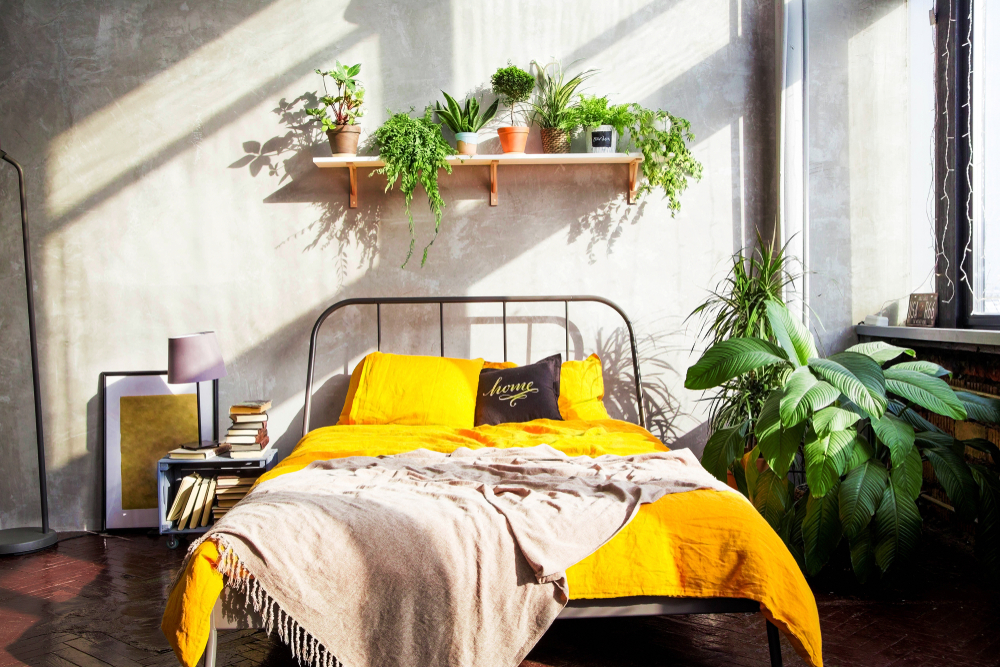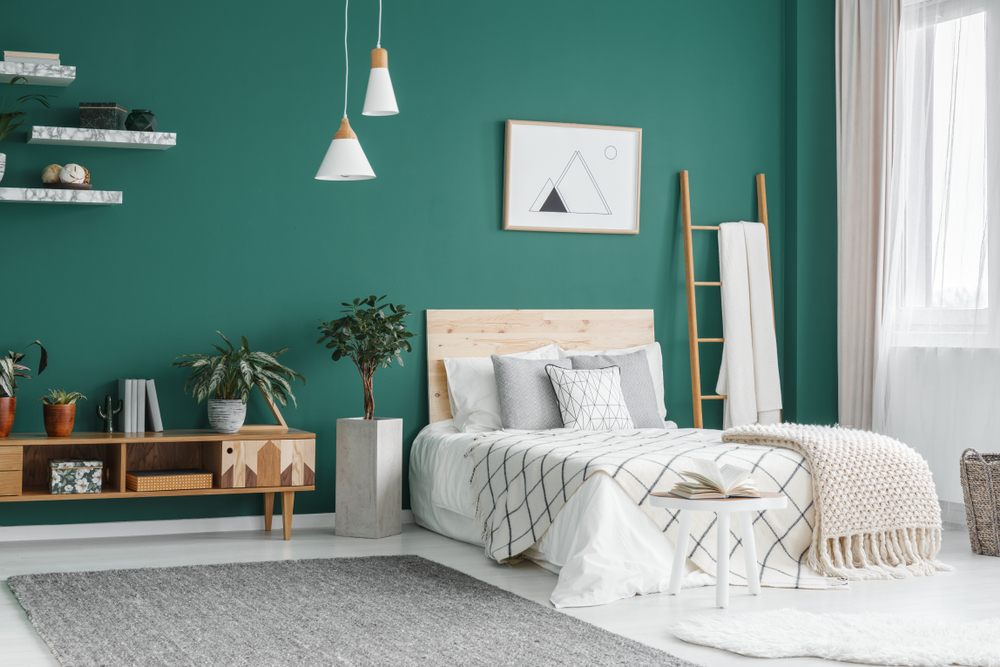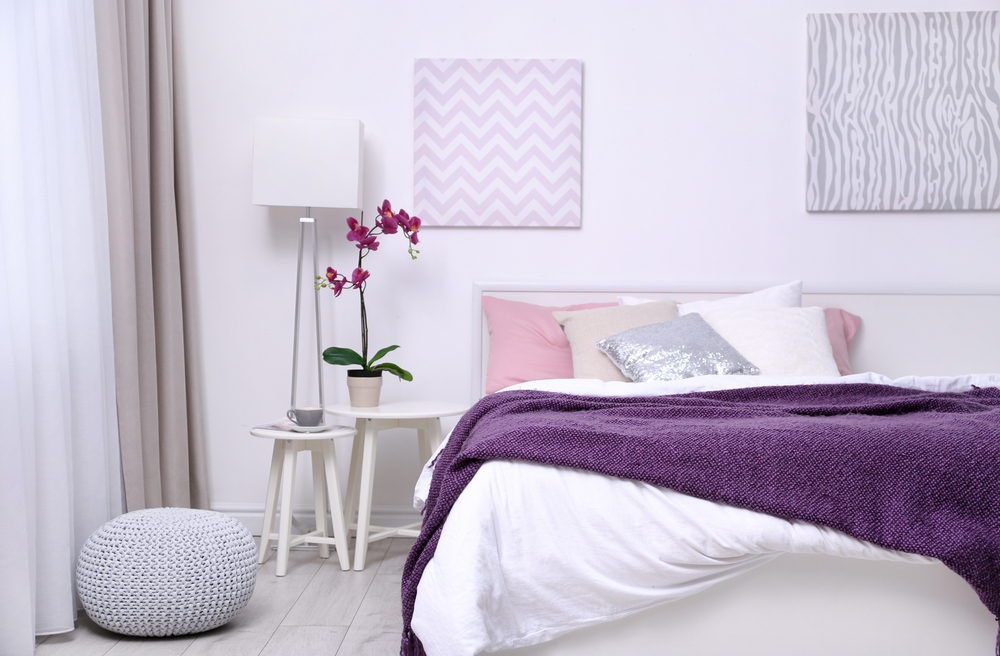Natural Colour Schemes Bedrooms
Understanding the best colours for your bedroom is important for getting the most out of our master suites.
The reason?
Colour plays a much bigger role than we first realise in our mood and happiness.
So, while most of us know by now that if we have a bad night's sleep we wake up cranky, not many of us adapt our bedroom colour schemes to help inspire joy.
Here, we explore colours that make us happy alongside some of the science behind how the colour of our bedroom affects both our mood and our sleep.
What are the best bedroom colours?
There are lots to consider when designing or decorating a bedroom. Interior design plays a big role in the quality of sleep and happiness too. So, it's important to emphasise your room's best qualities. One of the key factors to focus on is colour. Chances are you've heard the basics of how colours can affect your mood.
Warm colours, which include red, orange and yellow, are said to evoke feelings of warmth or even anger. Whereas certain cool colours – blue, green and purple – have been said to make you feel sad or indifferent.
But is there such a thing as good bedroom colours? And is there any science to back this up?
If so, which colours are best to enhance your mood? Here, we look into the best colour schemes for bedrooms that will make you happy according to colour psychology.
Related: 9 Bedroom Design Trends for 2020
Can colour affect our mood?
While there isn't a lot of scientific research behind colour psychology, anecdotal evidence suggests colours can affect mood and even performance. For example, a study on the colours of pills found that warm coloured placebo pills were reported as more effective than their cool counterparts. Also, the use of blue street lights in Tokyo has been said to reduce suicides and street crimes.
So, if colours can affect your mood, what are the best colours to use in the bedroom? It turns out the colours that make you happy could be subjective, with no clear answer for everyone. Discussing colour psychology for Very Well Mind, Kendra Cherry states:
"Your feelings about colour are often deeply personal and rooted in your own experience or culture. For example, while the colour white is used in many Western countries to represent purity and innocence, it is seen as a symbol of mourning in many Eastern countries."
However, even though the best colours to use for your bedroom are largely dependent on your personal preferences and experiences, there are common trends which are worth exploring when it comes to redecorating a room.
4 happy bedroom colour schemes
While scientific evidence is thin on the ground, a bedroom's colour is important. Experts in interior design have identified the below colour schemes for bedrooms as useful for helping limit anxiety and stress. Take a look at the best bedroom colour schemes to improve your mood:
1. Yellow

Incorporating yellow into the bedroom communicates happiness and is also ideal if your room doesn't get a lot of natural light, as it can mimic sunshine and make the room feel expansive. However, in large amounts, this colour is said to create feelings of frustration or anxiety.
We'd recommend bringing in pops of vibrant yellows to the bedroom with wall art, throws, or a single statement wall. Opt for neutral colours elsewhere to avoid an overwhelming look. Consider calming oatmeal, white, or pale grey for the other walls. You can also incorporate other natural materials such as wood to create your haven.
2. Blue

Blue is often considered as calming and serene, which is why it's a popular colour in bedrooms and bathrooms. Incorporate blue using light shades throughout the walls, as darker blues are said to evoke feelings of sadness.
Talking to Country Living, Sue Kim, a Valspar Colour Expert, states that a sky blue shade is "instantly calming and helps to restore natural rhythms." She adds:
"Growing evidence links sleep to productivity and overall well-being, and blue provides soothing and restorative qualities that can help improve rest."
If you'd like a slightly warmer blue, consider shades such as periwinkle which has hints of violet. These brighter shades can be brought in through bed linen, cushions, or home accessories. Pair your sophisticated blue tones with neutral colours such as beige or cream to continue the calming mood. Alternatively, experiment with shades of its complementary colour orange for a playful finish.
Related: Blue beds
3. Green

Green denotes nature which, according to several studies, has been proven to lift your mood. Bring this earthy colour into the bedroom subtly with the use of plants, or paint a wall a relaxing forest green shade to get the benefits. Further the biophilic trend by bringing lots of wood into the room, try oak shelves, beech bedside tables or wooden frames.
Related: How to Design Your Bedroom Colour Scheme for a More Relaxing Atmosphere
For something a bit brighter, opting for warmer shades in your bedrooms colour, such as a yellow-green can leave you feeling energised. Again, don't use too much of this colour as it might be overwhelming. Try a bold feature wall, or using yellow-green accessories such as cushions, throws or vases.
Related: Green headboards & Green beds
4. Lilac

As well as the above bold colours, opting for subtler shades with the colour of your bedroom can also have positive effects on your mood.
Relaxing bedroom colour schemes such as lilac brings restful qualities to a bedroom to help you sleep, as can other pastel shades such as blush pink or beige.
This subtle shade can be used on all of the bedroom walls as it isn't too overpowering. Incorporate more exciting colours such as darker shades of purple or hints of its complementary colour yellow. Again, bring these shades in through your curtains, throws or your wall art.
How does mood affect our sleep?
The chemicals, or neurotransmitters, in our brains are responsible for mood changes.
Neurotransmitters carry and deliver messages between brain cells in order to make us do, think or feel something. Among many other things, they are responsible for sleep regulation.
During a certain mood, different chemicals will be elevated in our brains. This can sometimes hinder our chances of a good sleep.
Here's a little insight into how our approach to sleep changes with different moods.
1. Happiness
You might be surprised to know that going to bed in a super happy state might not be ideal. Feeling content is fine but giddiness can cause your brain to work overtime meaning your body won't feel ready for bed. When you are in a state of extreme happiness, your brain produces a series of chemicals called Orexin. These chemicals suppress sleep and promote wakefulness; not ideal for settling down! That's why it's important to tone down overly bright rooms with neutral shades. You should also incorporate somesleep relaxation techniques into your sleep routine, such as deep breathing, writing in a journal or meditation. Over at 99designs.c0.uk, artist and designer Allison S. Gremillion explains:
Happy colors are bright, warm colors like yellow, orange, pink and red. Pastel colors like peach, light pink or lilac can also have an uplifting effect on your mood. The brighter and lighter a color, the more happy and optimistic it will make you feel.
2. Stress
We've probably all experienced nights spent tossing and turning due to stress or anxiety. That's because the body produces a neurotransmitter called norepinephrine when we're stressed which is the chemical most associated with the body's 'fight or flight' response. It increases heart rate and blood pressure, making it difficult for the body to relax. Sleep experts atTuck say:
'Neurons in the locus coeruleus in the bottom of the brain stem respond to norepinephrine. When these neurons are stimulated, the cortical area of the brain becomes more active. Norepinephrine is therefore thought to be instrumental in causing people to wake up.'
If you have a stressful day and are struggling to sleep, try drinking some Valerian tea. It is recommended to drink it an hour before bed to improve sleep quality and reduce anxiety. It is also said to have mild sedative qualities to send you off to sleep naturally.
Related: Can Bedroom Design Help You Sleep Better?
3. Depression & low mood
People who suffer with depression often have severe sleep trouble, whether it's constantly feeling tired or developing insomnia. This means it's difficult to get to sleep and remain in a comfortable sleep without waking. Depression isn't as simple as just feeling sad; it can be caused by a chemical imbalance which affects the way a person feels, thinks and acts.
People with depression often have low levels of Serotonin, the chemical most associated with contentment and security. A lack of Serotonin can cause issues within the sleep/wake cycle, which is why insomnia is so prevalent in depression sufferers.Livestrong says,
'Serotonin is synthesized by the pineal gland to make melatonin, the hormone that is directly related to healthy sleep'.
Without melatonin, our bodies find it difficult to differentiate night and day, meaning we don't automatically go into 'sleep mode' when it's dark.
Related: Melatonin And Sleep
Treatment for depression is different for every person, but you can increase your melatonin levels if you think this could improve your chances of quality sleep. Have a supper of porridge with banana, Morello cherries and ginger which are all high in melatonin.
To sum up, there isn't a lot of scientific research behind how colour affects your mood. However, anecdotal evidence suggests it can affect your frame of mind and consequently your sleep. The best bedroom colours we'd recommend to make you happy are yellow, blue, green and pastel shades such as lilac. But remember, don't go overboard or you may be too happy to sleep!
Want to know more? Check out all of our articles on bedroom design including 40 Bedroom Design Ideas To Improve Your Life.
Natural Colour Schemes Bedrooms
Source: https://www.dreams.co.uk/sleep-matters-club/bedroom-colour-schemes-will-make-happy/

Komentar :
Posting Komentar